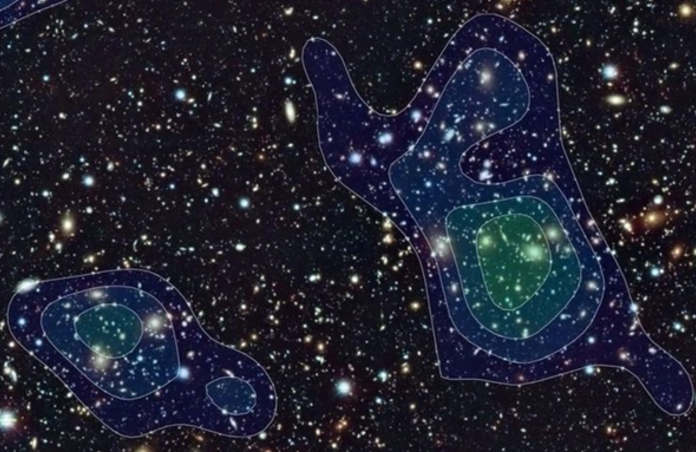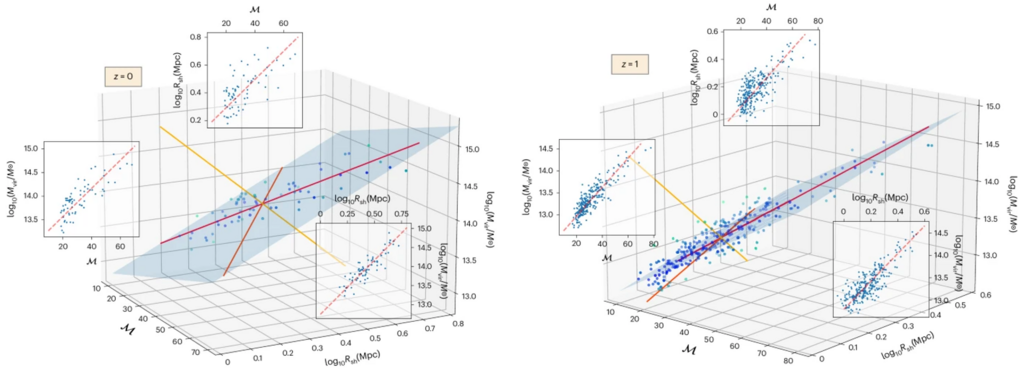Novel Approach to Measure Dark Matter in Galaxies

In cosmology, the prevailing model that describes the universe is the Lambda Cold Dark Matter (ΛCDM) model. It posits the existence of dark matter, which played a crucial role in the early formation of complex structures within an otherwise smooth, primordial universe. Dark matter is thought to interact only weakly, if at all, with most fundamental forces of nature, with the exception of gravity. Random density fluctuations in the early universe would collapse under self-gravity into dark matter halos, into which baryonic matter falls, forming various complex structures.
During this accretion phase, the baryonic matter would gain substantial kinetic energy, which is then abruptly lost in collisions with already accreted material at the centre of these halos. This discontinuous change in gas velocity creates a shock boundary between super- and subsonic gas flow. We can further classify these shocks as virial shocks, where the shock boundary lies at the virial radius of a gravitationally bound cluster of gas, and outer accretion shocks, located at the boundary where gas is first decelerated. These shocks produce heating of the gas, which we are able to detect in distant galaxy clusters.
A new study led by David Valléz-Pérez aims to leverage the properties of these shocks as a tracer to indirectly measure the dark matter component of a galaxy. The underlying principle is that stronger, more abrupt shocks form in galaxies that experienced intense gravitational accretion, indicating a greater dark matter mass component. The study investigates a sample of simulated galaxy clusters and their resulting accretion shocks. It aims to relate the dark matter mass to the shock radius and Mach number, which is the ratio of flow velocity to the local speed of sound, as an empirical fitting formula. The study also explores the evolution of this relationship as a function of cosmic time to enhance its applicability with observational measurements.

Investigating the properties of this relationship’s intrinsic scatter reveals the strength of their model in predicting galaxy mass. A crucial aspect is the use of the Mach number as a constraining parameter for mass, as it substantially reduces deviations compared to previously used mass-radius relationships. They find that their formula exhibits no systematic deviations with respect to redshift, meaning the formula’s effectiveness will hold for galaxies at any distance.
Valléz-Pérez et al. acknowledge that, while these initial results are promising, further considerations must be addressed. Notably, they found that using 3D simulations projected into 2D to replicate telescope measurements introduced an error of about 10%. Additionally, they identified another bias of around 10% related to galaxy mass. Future studies should explore a broader range of physical models to both confirm the relationship and mitigate these biases.
Overall, the study estimates that the intrinsic scatter of their formula introduces a 30% error within a 1σ confidence interval, which is comparable to other widely used methods. Although current observational facilities might find it challenging to accurately measure the intensity of these shocks, the authors remain optimistic that future advancements will enable this approach to offer a new and effective way to constrain dark matter distribution in the universe.
--
Journal Source: D. Valléz-Pérez et al, Cosmic accretion shocks as a tool to measure the dark matter mass of galaxy clusters, Nature Astronomy, (2024), DOI: https://doi.org/10.1038/s41550-024-02303-x
Cover Image Credit: Satoshi Miyazaki
